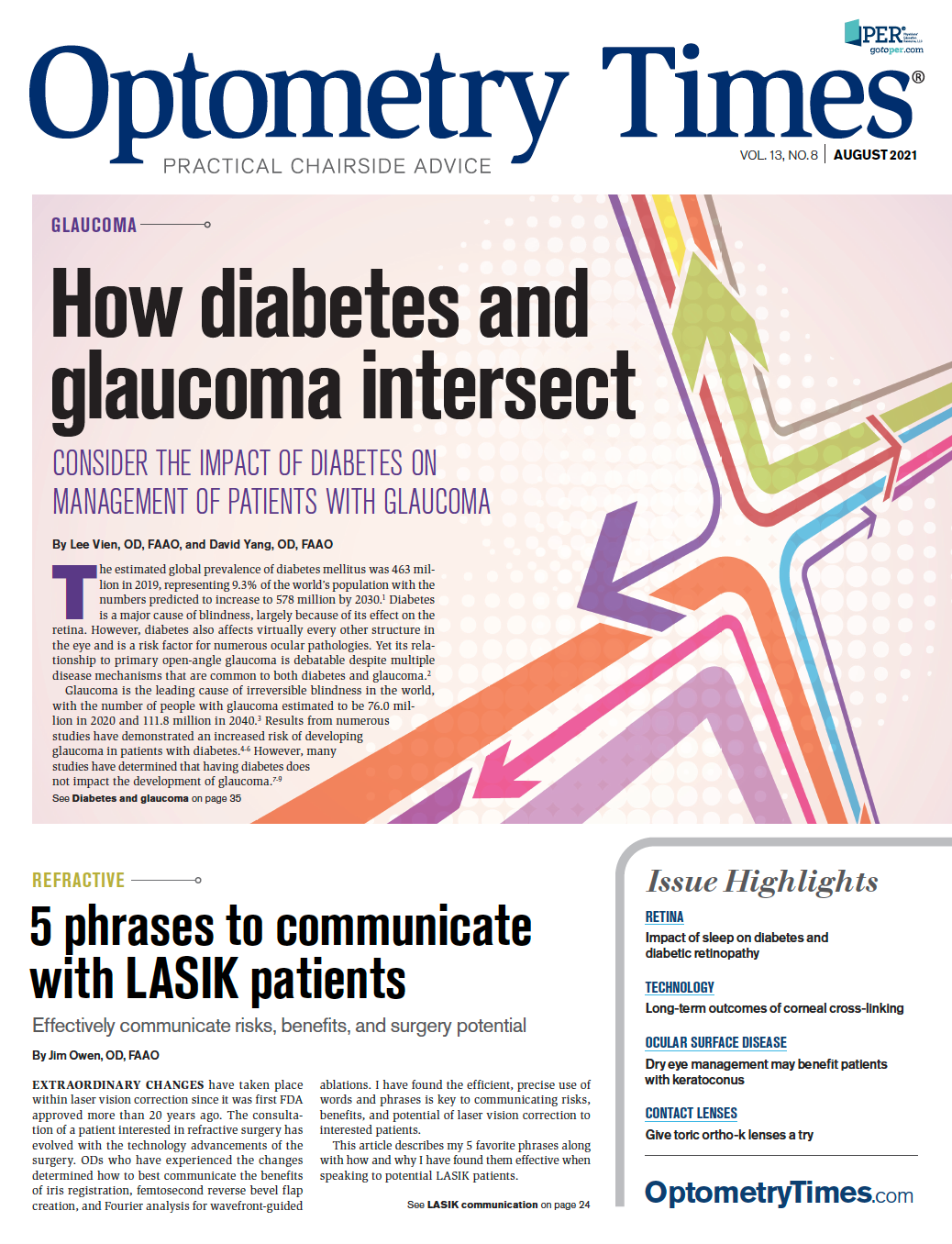- Therapeutic Cataract & Refractive
- Lens Technology
- Glasses
- Ptosis
- Comprehensive Eye Exams
- AMD
- COVID-19
- DME
- Ocular Surface Disease
- Optic Relief
- Geographic Atrophy
- Cornea
- Conjunctivitis
- LASIK
- Myopia
- Presbyopia
- Allergy
- Nutrition
- Pediatrics
- Retina
- Cataract
- Contact Lenses
- Lid and Lash
- Dry Eye
- Glaucoma
- Refractive Surgery
- Comanagement
- Blepharitis
- OCT
- Patient Care
- Diabetic Eye Disease
- Technology
New drug delivery system aims to improve adherence
Tackle one of the biggest challenges in managing patients with glaucoma


Adherence has always been one of the biggest challenges for clinicians and surgeons in the treatment and management of patients with glaucoma.1 Nonadherence to topical therapies is reported to be from 30% to 80%.2,3 Delivery system designs aim to optimize bioavailability while providing controlled, sustained drug release at the target site.4
Surgically implantable devices for sustained intravitreal release of ganciclovir (Vitrasert; Chiron [now discontinued]) over approximately 4 to 5 months developed in the 1990s for patients with acquired immunodeficiency syndrome (AIDS) and associated cytomegalovirus retinitis have served as paradigmatic cases for the treatment of ocular disease.5 Since then, many sustained-release drugs have been designed, most not reaching the criteria for FDA approval.
Durysta (bimatoprost implant; Allergan) is an FDA-approved, sustained-release (SR) biodegradable implant that is used to reduce the intraocular pressure (IOP) of patients with ocular hypertension or open-angle glaucoma.6 Durysta technically uses the same SR mechanism developed for Ozurdex (dexamethasone intravitreal implant; Allergan), a SR implant used by retina specialists for the treatment of macular edema associated with retinal vein occlusion and noninfectious uveitis.
Implant specifics
The Durysta implant contains 10 mcg of bimatoprost and is about 1 mm in length and 0.2 mm in diameter. The implant is preloaded in a sterile applicator and can be injected into the anterior chamber at the slit lamp or in a minor procedure setting. In either case, first give the patient topical anesthesia, followed by a drop of povidone-iodine (5% or 10%) or periocular povidone-iodine eyelid preparation (speculum use may be of benefit). Once inside the eye, the implant tends to sit in the inferior angle at 6 o’clock but may slide or rotate several clock hours in either direction.
Initially, the drug releases as aqueous fluid enters the implant pores. Fluid will continue to slowly penetrate the implant, causing it to soften and swell while it releases additional medication. By 3 months, most of the medication has been released, but the implant may remain present for up to 1 year or more. The rate of implant breakdown and biodegradation can vary widely, and this variation is a concern with serial injections. “Stacking” the implants in the inferior angle can lead to corneal endothelial cell loss, and at present the implant is approved for single use only. A single implant can last several months, and results from a phase 1/2 dose-ranging study found that 1 bimatoprost implant controlled IOP in 40% of patients for up to 12 months and 28% of patients for up to 24 months.7
Implant efficacy
In terms of efficacy, the implant provides similar pressure reduction to topical therapy. Though many indications exist for intracameral bimatoprost, many clinicians tend to use this medication in patients who have challenges with adherence or significant ocular surface disease.
The Artemis 1 study was a phase 3, multicenter, randomized, parallel-group, controlled clinical trial that compared the bimatoprost implant to 0.5% timolol eyedrops.8 The study was conducted for 20 months, and patients received 3 injections in total at 16-week intervals. The bimatoprost implant provided a 5- to 8-mm Hg mean IOP reduction over 15 weeks and was noninferior to timolol at all time points. Longer follow-up was obtained to determine efficacy after the final dose was delivered at 8 months. Following the third administration, the probability of not requiring additional IOP-lowering treatment for another year was 82.1% with the 10-mg dose.
Conclusion
As an alternative to multipharmaceutical topical therapies as well as minimally invasive glaucoma surgery or MIGS, Durysta provides the benefits of a sustained-release mechanism. These include less reliance on medication adherence and secondary ocular surface disease from topical or surgical treatment modalities. Although the implant procedure is performed by an ophthalmologist, several avenues exist for comanagement between optometry and ophthalmology, including patient selection and appropriate referral, pre- and postoperative care, and serial monitoring in the continued care of these patients.
Although questions remain about how this medication will be used in the future, it is currently a nice addition to the treatment regimen and of particular benefit to patients with adherence challenges. Sustained-release medications for glaucoma and other ocular conditions represent powerful opportunities to improve the health of our patients and our diverse patient communities.
References
1. Quigley HA, Friedman DS, Hahn SR. Evaluation of practice patterns for the care of open-angle glaucoma compared with claims data: the Glaucoma Adherence and Persistency Study. Ophthalmology. 2007;114(9):1599-1606. doi:10.1016/j.ophtha.2007.03.042
2. Olthoff CMG, Schouten JS, van de Borne BW, Webers CA. Noncompliance with ocular hypotensive treatment in patients with glaucoma or ocular hypertension an evidence-based review. Ophthalmology. 2005;112(6):953-961. doi:10.1016/j. ophtha.2004.12.035
3. Schwartz GF, Quigley HA. Adherence and persistence with glaucoma therapy. Surv Ophthalmol. 2008;53 (suppl 1):s57-s68. doi:10.1016/j.survophthal.2008.08.002
4. Epitropoulos AT. Longer-lasting benefits: Are sustained-release drugs the answer to ophthalmology’s topical drop problem? The Ophthalmologist. October 13, 2020. Accessed July 15, 2021. https:// theophthalmologist.com/subspecialties/longer-lasting-benefits
5. Sanborn GE, Anand R, Torti RE, et al. Sustained-release ganciclovir therapy for treatment of cytomegalovirus retinitis. Use of an intravitreal device. Arch Ophthalmol. 1992;110(2):188-195. doi:10.1001/ archopht.1992.01080140044023
6. Craven ER, Walters T, Christie WC, et al. 24-month phase I/II clinical trial of bimatoprost sustained-release implant (bimatoprost SR) in glaucoma patients. Drugs. 2020;80:167-179. doi: 10.1007/s40265- 019-01248-0
7. Aref AA. Durysta (bimatoprost implant). EyeWiki. May 3, 2021. Accessed July 2, 2021. https://eyewiki.aao.org/Durysta_ (Bimatoprost_Implant)
8. Medeiros FA, Walters TR, Kolko M, et al. Phase 3, randomized, 20-month study of bimatoprost implant in open-angle glaucoma and ocular hypertension (Artemis 1). Ophthalmology. 2020;127(12):1627- 1641. doi:10.1016/j.ophtha.2020.06.018

